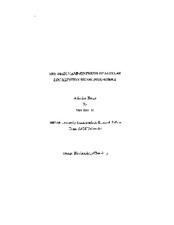| dc.contributor.advisor | Standaert, Robert F. | |
| dc.creator | Ho, Thai Huu | |
| dc.date.accessioned | 2013-02-22T20:41:46Z | |
| dc.date.available | 2013-02-22T20:41:46Z | |
| dc.date.issued | 1998 | |
| dc.identifier.uri | https://hdl.handle.net/1969.1/ETD-TAMU-1998-Fellows-Thesis-H63 | |
| dc.description | Digitized from print original stored in HDR. Due to the character of the original source materials and the nature of batch digitization, quality control issues may be present in this document. Please report any quality issues you encounter to digital@library.tamu.edu, referencing the URI of the item. | en |
| dc.description | Includes bibliographical references: leaves 28-29. | en |
| dc.description | Program year: 1997/1998 | en |
| dc.description.abstract | Nuclear import of proteins is a carefully controlled process that is critical for cellular function and regulation. A protein is marked for nuclear entry by a nuclear localization signal (NLS), a peptide motif, which typically consists of one or two small clusters rich in basic amino acids (lysine or arginine). Transport occurs through pores that span the nuclear envelope by a receptor mediated, energy-dependent process. The goal of this study is to synthesize mimics of the NLS from aminoalkylated dihydroxybenzene fragments joined with linkers of various length, rigidity, and directional constraint. The project is part of a larger effort to understand the molecular recognition in nuclear protein import; its emphasis is to study the role of charge placement, orientation, and linker features in NLS recognition. Modeled after the NLS of the HIV-1 matrix protein, the proposed molecules can mimic the side chain placement of the NLS template. Candidates are evaluated for inhibition in an in vitro nuclear import assay. Inhibition was not observed for all the candidates despite the presence of positively charged clusters. The results suggest inhibition is not solely based on the presence of positive charge and confirms the hypothesis that other factors, such as orientation, are important. | en |
| dc.format.extent | 31 pages | en |
| dc.format.medium | electronic | en |
| dc.format.mimetype | application/pdf | |
| dc.language.iso | en_US | |
| dc.rights | This thesis was part of a retrospective digitization project authorized by the Texas A&M University Libraries in 2008. Copyright remains vested with the author(s). It is the user's responsibility to secure permission from the copyright holder(s) for re-use of the work beyond the provision of Fair Use. | en |
| dc.subject | nuclear localization signal | en |
| dc.subject | molecular recognition | en |
| dc.subject | nuclear protein import | en |
| dc.subject | aminoalkylated dihydroxybenzene | en |
| dc.title | The design and synthesis of nuclear localization signal (NLS) mimics | en |
| dc.type | Thesis | en |
| thesis.degree.department | Chemistry | en |
| thesis.degree.grantor | University Undergraduate Research Fellow | en |
| thesis.degree.name | Fellows Thesis | en |
| thesis.degree.level | Undergraduate | en |
| dc.type.material | text | en |
| dc.format.digitalOrigin | reformatted digital | en |


